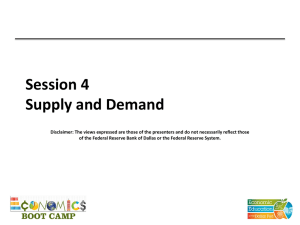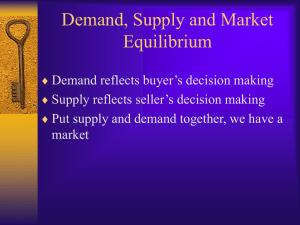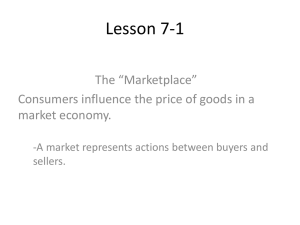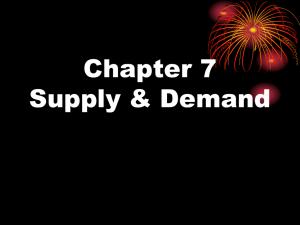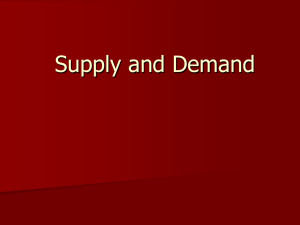Key Terms for Microeconomics
advertisement
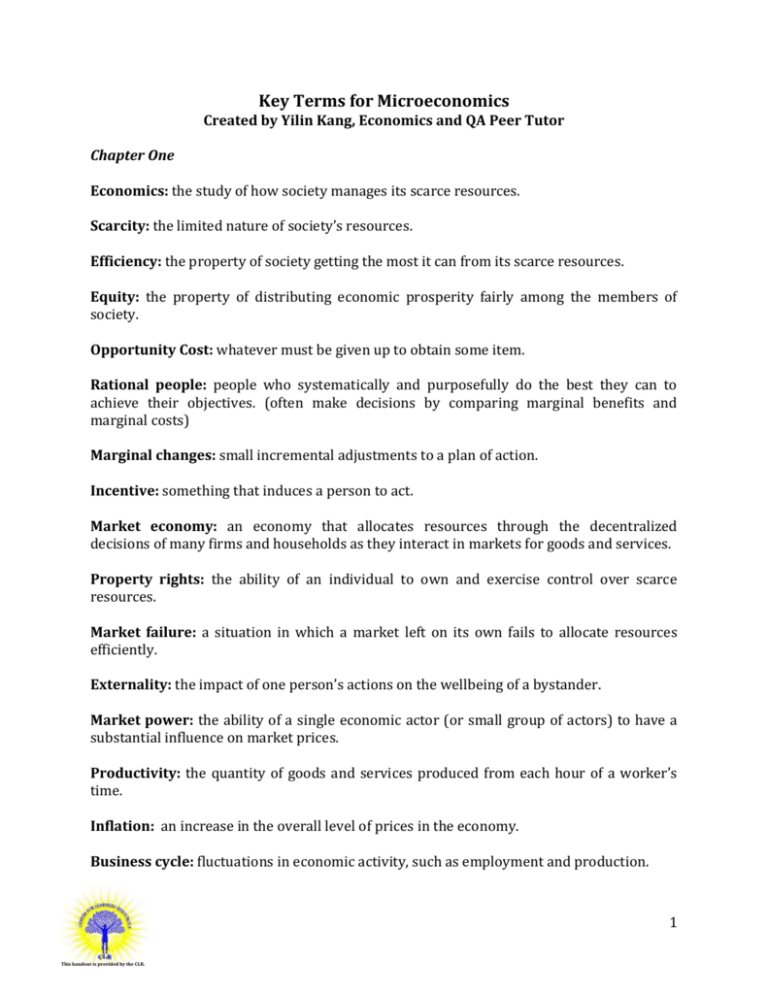
Key Terms for Microeconomics Created by Yilin Kang, Economics and QA Peer Tutor Chapter One Economics: the study of how society manages its scarce resources. Scarcity: the limited nature of society’s resources. Efficiency: the property of society getting the most it can from its scarce resources. Equity: the property of distributing economic prosperity fairly among the members of society. Opportunity Cost: whatever must be given up to obtain some item. Rational people: people who systematically and purposefully do the best they can to achieve their objectives. (often make decisions by comparing marginal benefits and marginal costs) Marginal changes: small incremental adjustments to a plan of action. Incentive: something that induces a person to act. Market economy: an economy that allocates resources through the decentralized decisions of many firms and households as they interact in markets for goods and services. Property rights: the ability of an individual to own and exercise control over scarce resources. Market failure: a situation in which a market left on its own fails to allocate resources efficiently. Externality: the impact of one person’s actions on the wellbeing of a bystander. Market power: the ability of a single economic actor (or small group of actors) to have a substantial influence on market prices. Productivity: the quantity of goods and services produced from each hour of a worker’s time. Inflation: an increase in the overall level of prices in the economy. Business cycle: fluctuations in economic activity, such as employment and production. 1 This handout is provided by the CLR. Ten Principles of Economics: 1. People Face Trade-offs 2. The Cost of Something Is What You Give Up to Get It 3. Rational People Think at the Margin 4. People Respond to Incentives 5. Trade Can Make Everyone Better Off 6. Markets Are Usually a Good Way to Organize Economic Activity 7. Governments Can Sometimes Improve Market Outcomes 8. A Country’s Standard of Living Depends on Its Ability to Produce Goods and Services 9. Prices Rose When the Government Prints Too Much Money 10. Society Faces a Short-Run Trade-off between Inflation and Unemployment Chapter Two Circular-flow diagram: a visual mode of the economy that shows how dollars flow through markets among households and firms. Production possibilities frontier: a graph that shows the combinations of output that the economy can possibly produce given the available factors of production and the available production technology. Microeconomics: the study of how households and firms make decisions and how they interact in markets. Macroeconomics: the study of economy-wide phenomena, unemployment, and economic growth. including inflation, Positive statements: claims that attempt to describe the world as it is. Normative statements: claims that attempt to prescribe how the world should be Slope= ∆y/∆x Chapter Three Absolute advantage: the ability to produce a good using fewer inputs than another producer. Comparative advantage: the ability to produce a good at lower opportunity cost than another producer. Imports: goods produced abroad and sold domestically. Exports: goods produced domestically and sold abroad. 2 This handout is provided by the CLR. Chapter Four Market: a group of buyers and sellers of a particular good or service. Competitive market: a market in which there are many buyers and many sellers so that each has a negligible impact on the market price. Quantity demanded: the amount of a good that buyers are willing and able to purchase. Law of demand: the claim that, other things equal, the quantity demanded of a good falls when the price of the good rises. Demand schedule: a table that shows the relationship between the price of a good and the quantity demanded. Demand Curve: a graph of the relationship between the price of a good and the quantity demanded. Normal good: a good for which, other things equal, an increase in income leads to an in crease in demand. Inferior good: a good for which, other things equal, an increase in income leads to a decrease in demand. Substitutes: two goods for which an increase in the price of one leads to an increase in the demand for the other. Complements: two goods for which an increase in the price of one leads to a decrease in the demand for the other. Quantity supplied: the amount of a good that seller are willing and able to sell. Law of supply: the claim that, other things equal, the quantity supplied of a good rises when the price of the good rises. Supply schedule: a table that shows the relationship between the price of a good and the quantity supplied. Supply curve: a graph of the relationship between the price of a good and the quantity supplied. Equilibrium: a situation in which the market price has reached the level at which quantity supplied equals quantity demanded. 3 This handout is provided by the CLR. Equilibrium price: the price that balances quantity supplied and quantity demanded. Equilibrium quantity: the quantity supplied and the quantity demanded at the equilibrium price. Surplus: a situation in which quantity supplied is greater than quantity demanded. Shortage: a situation in which quantity demanded is greater than quantity supplied. Law of supply and demand: the claim that the price of any good adjusts to bring the quantity supplied and the quantity demanded for that good into balance. Chapter Five Elasticity: a measure of the responsiveness of quantity demanded or quantity supplied to one of its determinants. Price elasticity of demand: a measure of how much the quantity demanded of a good responds to a change in the price of that good, computed as the percentage change in quantity demanded divided by the percentage change in price. Total revenue: the amount paid by buyers and received by sellers of a good, computed as the price of the good times the quantity sold. In come elasticity: a measure of how much the quantity demanded of a good responds to a change in consumers’ income, computed as the percentage change in quantity demanded divided by the percentage change in income. Cross-price elasticity of demand: a measure of how much the quantity demanded of one good responds to a change in the price of another good, computed as the percentage change in quantity demanded of the first good divided by the percentage change in the price of second good. Price elasticity of supply: a measure of how much the quantity supplied of a good responds to a change in the price of that good, computed as the percentage change in quantity supplied divided by the percentage change in price. Chapter Six Price ceiling: a legal maximum on the price at which a good can be sold. Price floor: a legal minimum on the price at which a good can be sold. Tax incidence: the manner in which the burden of a tax is shared among participants in a market. 4 This handout is provided by the CLR. Chapter Seven Welfare economics: the study of how the allocation of resources affects economic wellbeing. Willingness to pay: the maximum amount that a buyer will pay for good. Consumer surplus: the amount a buyer is willing to pay for a good minus the amount the buyer actually pays for it. Consumer surplus = Value to buyers – Amount paid by buyers Cost: the value of everything a seller must give up to produce a good. Producer surplus: the amount a seller is paid for a good minus the seller’s cost of providing it. Producer surplus = Amount received by sellers – Cost to sellers Total surplus = (Value to buyers – Amount paid by buyers) + (Amount received by sellers – Cost to sellers) The amount paid by buyers equals the amount received by seller: Total surplus = Value to buyers – Cost to sellers Efficiency: the property of a resource allocation of maximizing the total surplus received by all members of society. Equity: the fairness of the distribution of well-being among the members of society. Chapter Eight Deadweight loss: the fall in total surplus that results from a market distortion, such as a tax. Chapter Nine World price: the price of a good that prevails in the world market for that good. Tariff: a tax on goods produced abroad and sold domestically. Externality: the uncompensated impact of one person’s actions on the well-being of a bystander. 5 This handout is provided by the CLR. Internalizing the externality: altering incentives so that people take account of the external effects of their actions. Coase Theorem: the proposition that if private parties can bargain without cost over the allocation of resources, they can solve the problem of externalities on their own. Transaction costs: the costs that parties incur in the process of agreeing to and following through on a bargain. Corrective tax: a tax designed to induce private decision makers to take account of the social costs that arise from a negative externality. Chapter Eleven Excludability: the property of a good whereby a person can be prevented from using it. Rivalry in consumption: the property of a good whereby one person’s use diminishes other people’s use. Private goods: goods that are both excludable and rival in consumption. Public goods: goods that are neither excludable nor rival in consumption. Common resources: goods that are rival in consumption but not excludable. Free rider: a person who receives the benefit of a good but avoids paying for it. Cost-benefit analysis: a study that compares the costs and benefits to society of providing a public good. Tragedy of the commons: a parable that illustrates why common resources get used more than is desirable from the standpoint of society as a whole. Chapter Twelve Budget deficit: an excess of government spending over government receipts. Budget surplus: an excess of government receipts over government spending. Average tax rate: total taxes paid divided by total income. Marginal tax rate: the extra taxes paid on an additional dollar of income. Lump-sum tax: a tax that is the same amount for every person. 6 This handout is provided by the CLR. Benefits principle: the idea that people should pay taxes based on the benefits they receive from government services. Ability-to-pay principle: the idea that taxes should be levied on a person according to how well that person can shoulder the burden. Vertical Equity: the idea that taxpayers with a greater ability to pay taxes should pay larger amounts. Horizontal equity: the idea that taxpayers with similar abilities to pay taxes should pay the same amount. Proportional tax: a tax for which high-income and low-income taxpayers pay the same fraction of income. Regressive tax: a tax for which high-income taxpayers pay a smaller fraction of their income than do low-income taxpayers. Progressive tax: a tax for which high-income taxpayers pay a larger fraction of their income than do low-income taxpayers. Chapter Thirteen Total revenue: the amount a firm receives for the sale of its output. Total cost: the market value of the inputs a firm uses in production. TC = FC+VC Profit: total revenue minus total cost. Explicit costs: input costs that require an outlay of money by the firm. Implicit costs: input costs that do not require an outlay of money by the firm. Economic profit: total revenue minus total cost, including both explicit and implicit costs. Accounting profit: total revenue minus total explicit cost. Production function: the relationship between quantity of inputs used to make a good and the quantity of output of that good. Marginal product: the increase in output that arises from an additional unit of input. Diminishing marginal product: the property whereby the marginal product of an input declines as the quantity of the input increases. 7 This handout is provided by the CLR. Average total cost: total cost divided by the quantity of output ATC = TC/Q Average fixed cost: fixed costs divided by the quantity of output. AFC = FC/Q Average variable cost: variable costs divided by the quantity of output. AVC = VC/Q Marginal cost: the increase in total cost that arises from an extra unit of production. MC=∆TC/∆Q Efficient scale: the quantity of output that minimizes average total cost. Economies of scale: the property whereby long-run average total cost falls as the quantity of output increases. Diseconomies of scale: the property whereby long-run average total cost rises as the quantity of output increases. Constant returns to scale: the property whereby long-run average total cost stays the same as the quantity of output changes. Chapter Fourteen Competitive market: a market with many buyers and sellers trading identical products so that each buyer and seller is a price taker. Average revenue: total revenue divided by the quantity sold. Marginal Revenue: the change in total revenue from an additional unit sold. Sunk cost: a cost that has already been committed and cannot be recovered. Chapter Fifteen Monopoly: a firm that is the sole seller of a product without close substitutes. 8 This handout is provided by the CLR. Natural monopoly: a monopoly that arises because a single firm can supply a good or service to an entire market at a smaller cost than could two or more firms. Price discrimination: the business practice of selling the same good at different prices to different customers. Chapter Sixteen Oligopoly: a market structure in which only a few sellers offer similar or identical products. Monopolistic competition: a market structure in which many firms sell products that are similar but not identical. Collusion: an agreement among firms in a market about quantities to produce or prices to charge. Cartel: a group of firms acting in unison. Nash equilibrium: a situation in which economic participants interacting with one another each choose their best strategy given the strategies that all the others have chosen. Game theory: the study of how people behave in strategic situations. Prisoners’ dilemma: a particular “game” between two captured prisoners that illustrates why cooperation is difficult to maintain even when it is mutually beneficial. Dominant strategy: a strategy that is best for a player in a game regardless of the strategies chosen by the other players. Chapter Seventeen Monopolistic competition: a market structure in which many firms sell products that are similar but not identical. Chapter Eighteen Factors of production: the inputs used to produce goods and services. Production function: the relationship between the quantity of inputs used to make a good and the quantity of output of that good. 9 This handout is provided by the CLR. Marginal product of labor: the increase in the amount of output from an additional unit of labor. Diminishing marginal product: the property whereby the marginal product of an input declines as the quantity of the input increases. Value of the marginal product: the marginal product of an input times the price of the output. Capital: the equipment and structures used to produce goods and services. Chapter Nineteen Compensating differential: a difference in wages that arises to offset the nonmonetary characteristics of different jobs. Human capital: the accumulation of investments in people, such as education and on-thejob training. Union: a worker association that bargains with employers over wages and working conditions. Strike: the organized withdrawal of labor from a firm by a union. Efficiency wages: above-equilibrium wages paid by firms to increase worker productivity. Discrimination: the offering of different opportunities to similar individuals who differ only by race, ethnic group, sex, age, or other personal characteristics. Chapter Twenty Poverty rate: the percentage of the population whose family income falls below an absolute level called the poverty line. Poverty line: an absolute level of income set by the federal government for each family size below which a family is deemed to be in poverty. In-kind transfers: transfers to the poor given in the form of goods and services rather than cash. Life cycle: the regular pattern of income variation over a person’s life. Permanent income: a person’s normal income. 10 This handout is provided by the CLR. Utilitarianism: the political philosophy according to which the government should choose policies to maximize the total utility of everyone in society. Utility: a measure of happiness or satisfaction. Liberalism: the political philosophy according to which the government should choose policies deemed to be just, as evaluated by an impartial observer behind a “veil of ignorance”. Maximin criterion: the claim that the government should aim to maximize the well-being of the worst-off person in society. Social insurance: government policy aimed at protecting people against the risk of adverse events. Libertarianism: the political philosophy according to which the government should punish crimes and enforce voluntary agreements but not redistribute income. Welfare: government programs that supplement the incomes of the needy. Negative income tax: a tax system that collects revenue from high-income households and gives transfers to low-income households. Chapter Twenty-one Budget constraint: the limit on the consumption bundles that a consumer can afford. Indifference curve: a curve that shows consumption bundles that give the consumer the same level of satisfaction Marginal rate of substitution: the rate at which a consumer is willing to trade one good for another. Perfect substitutes: two goods with straight-line indifference curve. Perfect complements: two goods with right-angle indifference curves. Normal good: a good for which an increase in income raises the quantity demanded. Inferior good: a good for which an increase in income reduces the quantity demanded. Income effect: the change in consumption that results when a price change moves the consumer to a higher or lower indifference curve. 11 This handout is provided by the CLR. Substitution effect: the change in consumption that results when a price change moves the consumer along a given indifference curve to a point with a new marginal rate of substitution. Giffen good: a good for which an increase in the price raises the quantity demanded. Chapter Twenty-two Moral hazard: the tendency of a person who is imperfectly monitored to engage in dishonest or otherwise undesirable behavior. Agent: a person who is performing an act for another person, called the principal. Principal: a person for whom another person, called the agent, is performing some act. Adverse selection: the tendency for the mix of unobserved attributes to become undesirable from the standpoint of an uninformed party. Signaling: an action taken by an informed party to reveal private information to an uniformed party. Screening: an action taken by an uninformed party to induce an informed party to reveal information. Condorcet paradox: the failure of majority rule to produce transitive preferences for society. Arrow’s impossibility theorem: a mathematical result showing that, under certain assumed conditions, there is no scheme for aggregating individual preferences into a valid set of social preferences. Median voter theorem: a mathematical result showing that if voters are choosing a point along a line and each voter wants the point closest to his most preferred point, then majority rule will pick the most preferred point of the media voter. 12 This handout is provided by the CLR.
